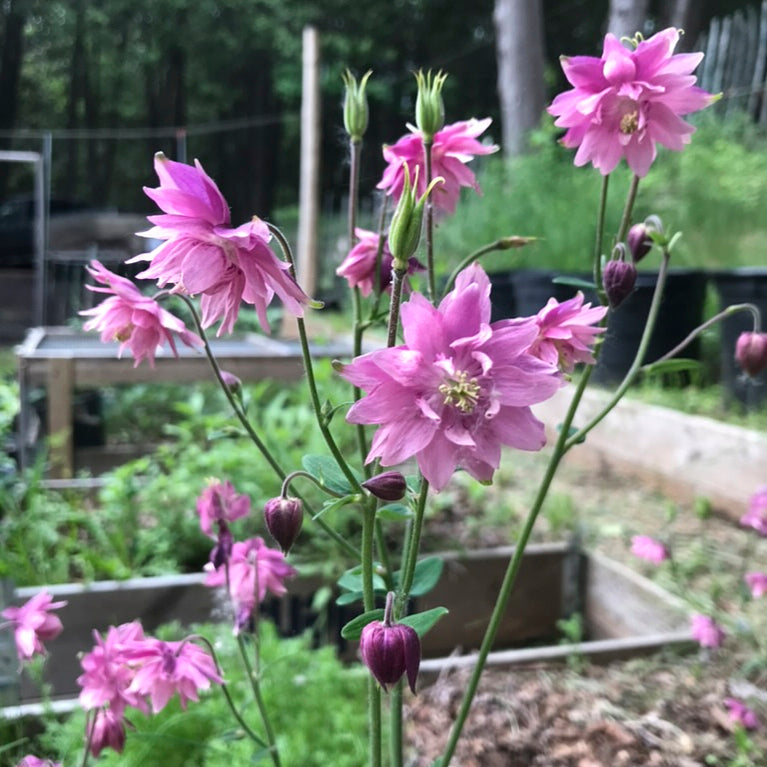
A double-flowered Canada columbine (Aquilegia canadensis) nativar.
Understanding the issues surrounding nativars: a compromise between aesthetics and ecology
Nativars, often presented as a balance between native plants and modern horticulture, raise important questions about their ecological impact. These cultivars derived from native plants are selected for specific traits, such as a unique colour or a compact size. But what are their repercussions on local ecosystems and biodiversity?
Before addressing the issue of nativars, it is important to clarify some key terms:
Wild plant: A plant that grows naturally in a given environment without human intervention, is adapted to local conditions, and is often essential to biodiversity.
Native plant: A plant that grows naturally in a specific geographical region without human intervention. Having evolved over thousands of years, it has adapted to the climate, wildlife, and local soils, contributing to the balance and health of ecosystems.
Cultivar: A cultivated plant variety, selected and propagated for specific characteristics such as colour, size, or disease resistance.
Nativar: A cultivar derived from a native plant, modified to meet aesthetic or horticultural preferences.
What is a nativar?
Nativars are cultivated varieties of native plants, often modified to meet gardeners’ aesthetic preferences. These modifications may include brighter flower colours, variegated foliage, or specific growth forms. These changes do not always impact ecological interactions. For example, nativars like the ‘Princeton’ American elm, resistant to Dutch elm disease, retain their original ecological functions.
However, other modifications, such as a change in leaf colour, can have unexpected consequences. Studies show that these alterations can reduce the plant’s ability to support native insects, particularly specialist herbivores. As renowned entomologist Douglas Tallamy points out, each case must be evaluated individually.
Douglas Tallamy, founder of Homegrown National Park®, questions the idea that nativars are an ideal gateway to native plants for gardeners. He highlights two main limitations: their multiplication by cuttings or division (clonal propagation), which eliminates all genetic variability essential for adaptation to climate change, and their selection based on aesthetics, which perpetuates the idea that plants are merely decorative. He advocates for the sale of “pure” native species alongside nativars, allowing those who wish to promote ecological restoration and maximize their environmental benefits to make an informed choice.
The impact of nativars on biodiversity
One of the main debates concerning nativars is their ability to support local wildlife. While some nativars retain their ecological value, others may have traits that limit their usefulness for pollinators and other species. For example, double-flowered nativars can block access to nectar and pollen, depriving pollinators of an essential food source.
Furthermore, nativars are often propagated vegetatively, such as by cuttings or division, to preserve the specific characteristics for which they were selected. However, this method eliminates the genetic variability that characterizes wild native plants. This can affect their ability to adapt to changing environmental conditions, including diseases or pests, thereby compromising their ecological role.
Genetic diversity and ecological resilience
Genetic diversity plays a fundamental role in ecosystem resilience. It enables plant species to adapt to environmental disturbances such as climate change or habitat loss. When this diversity is compromised, ecosystem adaptability and stability suffer.
Conservation efforts must include the preservation of varied genetic traits to maintain ecological functions and support biodiversity. Native plants propagated from local varieties (also called genotypes) can help preserve the co-evolved relationships between plants and local species.
Aesthetics versus ecology: a necessary compromise?
Nativars are often designed to meet gardeners’ expectations, but these modifications can come at an ecological cost. Some traits, such as flower sterility, can eliminate essential functions such as seed production. This can reduce the resources available for wildlife that depend on these plants for food or reproduction.
Prioritizing native plants: a thoughtful choice
Not all nativars are equal. While these varieties can help popularize the use of native plants in gardens and landscapes, encouraging greater awareness of local biodiversity, it is crucial to consider the repercussions of a nativar before making a choice. Often selected for their aesthetic appeal, these cultivars may not fulfill essential ecological needs, such as supporting native wildlife or preserving genetic diversity. Informing oneself and prioritizing well-adapted native plants remains essential to actively contributing to ecosystem preservation.
Nativars may seem like an appealing solution for introducing native plants into our gardens, but it is crucial not to overlook the importance of true native species. These are perfectly adapted to their environment and play an irreplaceable role in supporting local ecosystems and biodiversity. By prioritizing native plants over cultivars or nativars, we make a choice that directly contributes to ecological resilience and the well-being of our planet. Thus, every garden can become a refuge for wildlife and a model of harmony with nature.

An American painted lady (Vanessa virginiensis) on slender mountainmint (Pycnanthemum tenuifolium).
Sources
A Way to Garden with Margaret Roach. (n.d.). How effective are nativars? with Doug Tallamy. Retrieved January 17, 2025, from https://awaytogarden.com/nativars-with-doug-tallamy/
Ecogardens. (n.d.). Should you use nativars in your garden? Retrieved January 17, 2025, from https://info.ecogardens.com/blog/should-you-use-nativars-in-your-garden
Greenhouse Grower. (n.d.). The issue of nativars. Retrieved January 17, 2025, from https://www.greenhousegrower.com/crops/the-issue-of-nativars/
Grow Native! (n.d.). Natives, cultivars, and "nativars." Retrieved January 17, 2025, from https://grownative.org/learn/natives-cultivars-and-nativars/
Kenosha County UW-Extension. (n.d.). Genetic diversity and plant preservation. Retrieved January 17, 2025, from https://kenosha.extension.wisc.edu/files/2020/03/Genetic-Diversity-and-Plant-Preservation-PDF.pdf
Laidback Gardener. Hodgson, Larry. (2017, April 20). Double flowers: Bad news for pollinators. Retrieved January 17, 2025, from https://laidbackgardener.blog/2017/04/20/double-flowers-bad-news-for-pollinators/
National Center for Biotechnology Information (NCBI). (n.d.). Genetic diversity and ecological resilience. Retrieved January 17, 2025, from https://pmc.ncbi.nlm.nih.gov/articles/PMC9859222/
National Wildlife Federation. (2016, June/July). Cultivars: Native, or not so much? National Wildlife. Retrieved January 17, 2025, from https://www.nwf.org/Magazines/National-Wildlife/2016/JuneJuly/Gardening/Cultivars
Wild Ones. (n.d.). Guidelines for selecting native plants. Retrieved January 17, 2025, from https://wildones.org/resources/guidelines-for-selecting-native-plants/

